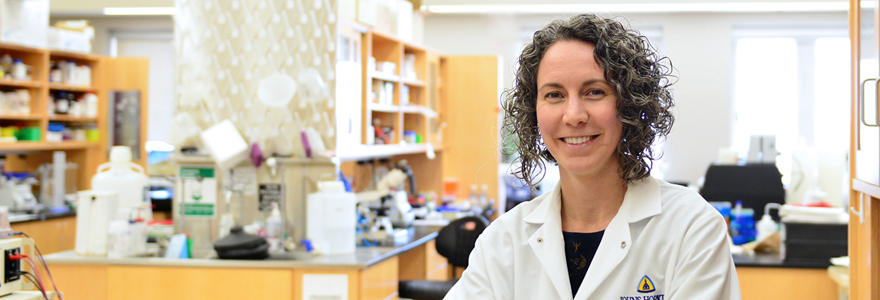Bacterial communities and HIV: How the penile microbiome influences transmission

By Emily Leighton, MA'13
A small flap of skin. A network of bacteria. And an incurable virus. It’s a dramatic story playing out in the tiny community of microorganisms living on the penis.
For researcher Jessica Prodger, PhD, the relationship between the penile microbiome and HIV is an essential piece in understanding the virus and preventing transmission. “Your genital microbiome, like all your microbiomes, is incredibly essential to your health,” she explained.
Her lab is creating a 3D-organotypic foreskin culture model – in simple terms, an artificial foreskin in a dish – to study the penile microbiome.
Prodger, an assistant professor with the Department of Microbiology and Immunology, is exploring why circumcision is protective and how the penile microbiome may contribute to HIV incidence in heterosexual men.
For an uncircumcised man, the penile microbiome is characterized by a high abundance of anaerobic bacteria – microbes that thrive in areas deprived of oxygen, such as under the foreskin. After circumcision, this burden of anaerobic bacteria decreases significantly.
The presence of anaerobes is associated with subtle, asymptomatic inflammation. And because inflammation on the penis recruits immune cells susceptible to HIV infection, called CD4 T-cells, this means certain microbes likely increase the risk of uncircumcised men contracting HIV.
“The ongoing inflammation that results from these anaerobic bacteria is actually bringing more of the very cells that HIV wants to infect,” Prodger explained. “When a man has sex with an HIV-infected woman, this tissue that is rich in HIV-target cells is exposed to virus in her genital secretions, and because there are more target cells, he may be more likely to get infected.”
The artificial foreskin being developed by her lab will help investigate how this process unfolds. “We want to get at the exact culprits, to tease out exactly which networks of bacteria are the problem,” she said.
Using the model, researchers will be able to coculture potential problem anaerobes with whole polymicrobial communities for in vitro experiments focused on human cell response.
In addition to prevention, Prodger is also interested in HIV cure research.
HIV integrates into the DNA of human cells, making it difficult to fully eradicate. Known as the latent HIV reservoir, dormant cells can harbour HIV, hiding in the body for decades.
Prodger is part of an international collaborative effort to better understand and characterize this latent reservoir. “We need to know who we’re dealing with,” she said. “How many cells do we need to worry about? What type of cells? Where are they located?”
Most of the studies attempting to answer these questions have been performed in North American populations. But as Prodger points out, HIV is a different epidemic in Sub-Saharan Africa. The route of infection, genetic strains of HIV, individual exposure and access to medical care are all reasons to believe the latent HIV reservoir may look and act differently.
Prodger partnered with researchers at Johns Hopkins and the National Institutes of Health (NIH) to study a cohort of individuals living with HIV in Rakai, Uganda. With a large blood draw from the study group, the research team used reservoir quantification techniques developed by Bob and Janet Siliciano at Johns Hopkins to get an idea of the frequency of latently-infected cells. They then compared that data to previous quantifications done in North America.
“We found that the reservoir in Ugandans was actually far smaller than that observed in North Americans,” said Prodger.
Her current cure research continues to ask questions about why this might be and to further characterize the reservoir observed in Ugandan populations.
Prodger’s interest in global health flourished during her graduate studies at the University of Toronto. At that time, the 10/90 gap in health research, where 90 per cent of the world's research dollars were put toward 10 per cent of its population, was being highly publicized. “I thought I might be on the wrong side of the fence and wanted to change that,” she said. “I was driven by this idea to step to the other side of the gap.”
Following her doctoral degree, she pursued a fellowship in epidemiology at Johns Hopkins’ Bloomberg School of Public Health and completed her postdoctoral training at NIH.
Looking for a Canadian institution with a strong HIV research team, Prodger joined the faculty at Schulich Medicine & Dentistry in January 2018.
She says the opportunity to connect with fellow HIV researchers, through groups like the Western HIV Investigators Group (WHIG), is a big advantage. “Getting to work with other scientists that come from different backgrounds and perspectives, but who have similar goals and interests, is invaluable in developing research questions and programs,” she said.


